
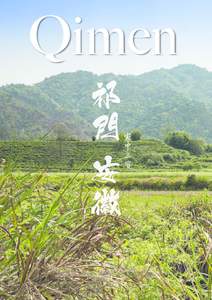 |
|
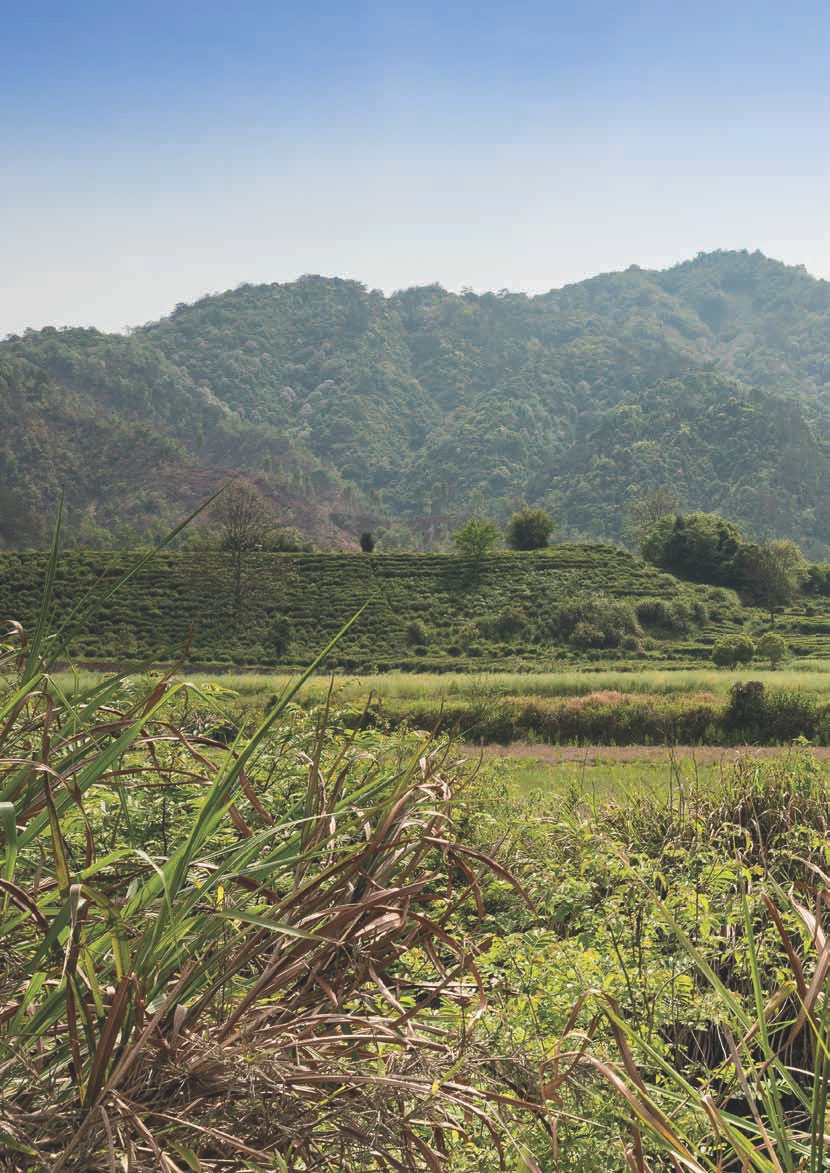
The horizon draws a crisp line between the blue sky and the green forest; spring has arrived right on time in Qimen County. Beneath the March skies, the green hills keep company with soft white clouds, the clear water reflects the trees, the fragrance of tea wafts above the fields, and in the quiet villages, the old houses silently narrate their stories...
There's a faint chill in the air, and the leaves have begun to yellow; announcing itself with glorious colors, autumn keeps its appointment. On Qimen's White Dew nights in mid-autumn, the tranquility of the mountains is underscored by the gentle rustling of streams; the glow of moonlight settles across the fields, and Liu An tea leaves lie silently outdoors, spread on their mats, waiting to encounter the night dew and absorb its gift of moisture.
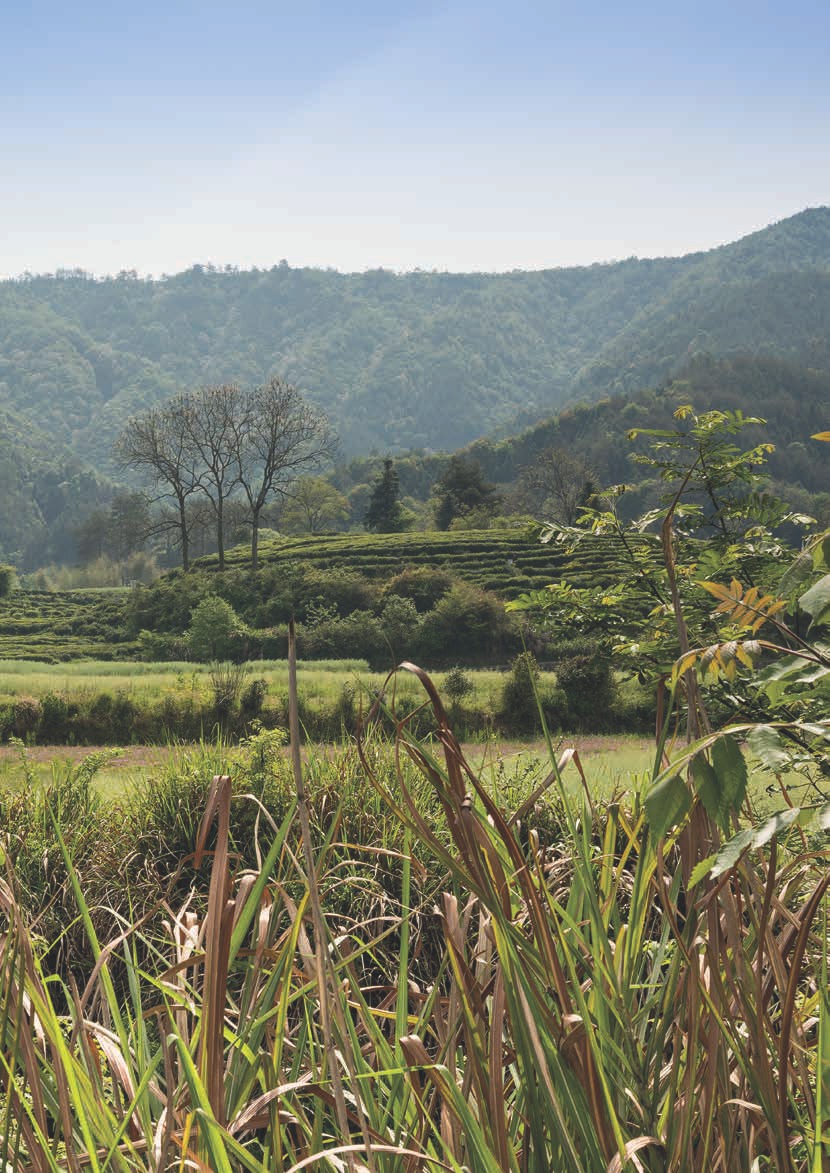
My journey in pursuit of Liu An tea led to two visits to Qimen County in Huangshan, Anhui Province, once in the spring and once in the autumn. In the tranquility of the springtime, the crisp air was so calm that it seemed to solidify, so that one almost forgot to breathe in the still of the moment. In the autumn, the romantic mountain scenery carried the eye across the landscape, linking forest and peak like the words of a poem.
Qimen's natural charm doesn't just manifest itself in the forests and mountains, but also in the tea plantations nestled among them, nourished by the earth. Qimen is located in a region recognized the world over as the "golden belt" of tea production. Stretching across China at a latitude of 30° north of the equator, the teas produced around this area include not only those from Qimen itself, such as Qimen (Keemun) red tea, An tea and Huangshan Maofeng, but also a variety of other famous historical teas, such as West Lake Longjing, Dongting Biluochun, Junshan Silver Needle, Mengding Ganlu, Lushan Clouds and Mist and Taiping Houkui. The region's unique geographical landforms, abundant rainfall and sunlight, and rich biodiversity all come together to make it a veritable paradise for tea plants.
More than 90% of the total area of Qimen County is made up of mountainous terrain, which gave rise to a local saying: "nine mountains, half a lake and half a field." About 85% of the county is forested, with trees growing over all sorts of unusual landforms. Most of the region's tea plantations are situated in the densely forested hills and valleys. Also located here is the national AAAA-rated Guniujiang Nature Reserve, dubbed "Eastern China's last primeval forest." To truly experience Qimen's scenery, you really must visit the ancient forests of Guniujiang. They say that the pine trees here are even more uniquely twisted than the renowned crooked pines of Huangshan and the waterfalls are even more elegant than the famous ones at Lushan.

Guniujiang, with its ethereal scenery, is located near Likou Village, in the northwest of Qimen County. The name "Guniujiang (牯牛降)" literally means "descending bull" - it's named after a large black rock on one of the peaks, which from afar looks like a bull sitting peacefully, having just landed from the sky. These mountains are part of a range that branches off from Huangshan and extends toward the west. The landscape here is built of stone; the mountain peaks are pointed and craggy, with steep slopes that extend straight down to the gloriously lush valley floor. Rocks of strange and wondrous shapes are dotted across the landscape like stars in the sky, adding to the magic of the scenery.
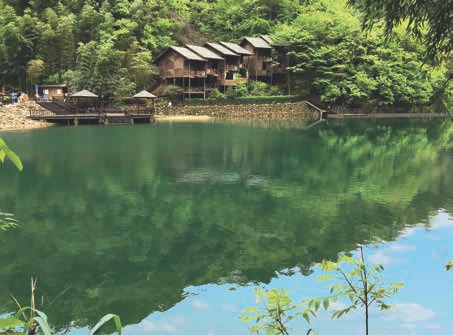

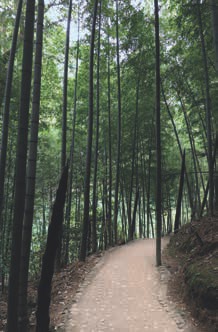

There's a saying that goes: "The mountain gets its life from the water, and the water takes on the serenity of the mountain; the more beautiful the mountain, the more graceful its waters." The waters of Guniujiang are clear as crystal and green as jade, and quite moving to behold. Pure, clean, clear and bright, spotless as the fabled Peach Blossom Spring, the area is covered with springs and creeks, pools and streams, all beautifully clear and turquoise-green. The green pools quietly reflect the forest trees; the whole effect is just like standing in a real-life painted scroll.
If, as they say, a mountain gets its life from the water, then the mountains of Guniujiang are lively indeed - its waterfalls are pure motion, cascading over clifftops like long strings of pearls, each droplet sparkling. As the water descends from the sky and crashes into the valley below, a mist of spray rises; lit by the sun's rays, it naturally forms a rainbow, painting an enchanting many-colored brushstroke across the landscape.
If you follow the streams down into the valley, you'll end up deep in the forest. At the foot of the mountain, the broad-leaved evergreen forest is a deep green, a steady green; if you look up toward the midslopes, the brushwood forest becomes brighter, the translucent green of jade; look up further still, and the forest atop the mountain forms a verdant line against the sky, a shining green, a fresh and vibrant green. Sprinkled across these layers are flowers of all colors, dots of brightness to complement the greens, raising their petals with joyful abandon to the sun.
As well as mountain flowers that brighten the village, the yellow oilseed flowers bloom in early March to herald the arrival of spring. In the distance, mountain ranges form a many-layered background, and rows of tea trees cover the slopes; the tea trees in the village itself are lush and green. Against this backdrop, it looks just like the yellow-green flowers were scattered across the fields from the heavens. The green of Mother Earth sets off their delightful color, and the farmhouses between the criss-crossed paths bring a warm, familiar feeling to the flowering fields. Every year, when the flowers open, the area attracts many photography enthusiasts, hoping to capture this fleeting spring feeling.

In Qimen, the most beautiful scenery is to be found in the countryside. Qimen's simple mountain villages, nestled among overlapping mountain ranges, afford a quite different view than urban areas. Amid the landscape, the old black-and-white farmhouses have stood there for generations, between the Earth and the Sky. Among the meandering hills, the green waters wind along, the swaying shadows of the trees slowly changing with the sunlight from dusk till dawn. When the sun emerges from the lingering clouds and mist at dawn, or after a rainstorm, the black-and-white houses are suddenly lit up brilliantly; it's a special moment, a feeling that you'll only experience in the Anhui countryside.
These houses, with their white walls and black roof tiles, are typical of Anhui Province and represent one branch of traditional Han Chinese architecture. You can find this style of architecture throughout the six counties in the Huizhou District of southern Anhui, namely She, Yi, Wuyuan (which today is a part of Jiangxi Province), Xiuning and Jixi counties, along with the destination of our visit, Qimen County. The houses, ancestral temples and memorial archways are the most famous types of buildings in this style, and are celebrated as the three wonders of traditional Huizhou architecture. A notable feature of this style is its "horse-head walls (馬頭墻)," a style where the top of the wall has a series of tiers ending in upturned gables, which shape is reminiscent of a horse's head. The buildings in Huizhou style are often decorated with murals or intricate carvings.
A trip to Qimen County would not be complete without visiting Tao yuan ("Peach Spring") Village, named after the ethereal village depicted in the classic work Peach Blossom Spring (桃花源記) by poet Tao Yuanming. (In the story, a fisherman discovers an unknown village, a beautiful and harmonious utopia, which has had no contact with the outside world for centuries.) This real-life Peach Spring village lies between mountains on one side and a river on the other, and naturally follows the slope of the mountain. This layout is typical of alpine villages in Huizhou, and shows the importance placed on feng shui (Daoist geomancy) in local Huizhou culture. The river in front of the village is named Rabbit Ear Creek. It encircles the village like a band of jade, chattering and murmuring as it flows by. The ancient forest behind the village, on Lai Long ("The Coming of the Dragon") Mountain, stands in peaceful silence.
Across Rabbit Ear Creek, in front of the village, the villagers have built a covered bridge, a necessity for life by a river. In Huizhou's traditional mountain villages, a bridge was often built across the outlet of a river (where the water flows away from the village) to act as a sort of "lock" for the feng shui of the area. Beside the bridge, people would build pavilions, dams and embankments, and would plant plants; all these were intended to preserve the balance of feng shui, ensuring prosperity and peace. Our ancestors thought much more about the design of their villages.
After crossing the bridge to the village, you will encounter the buildings of the village, their "horse heads" held proudly aloft. Wandering among them, you'll come across whitewashed walls both high and low, roofed with rows of black tiles; you'll marvel at the intricate carvings of the wooden window panels, meander down alleyways paved with gray stone, and quietly take in the grand and solemn ancestral temples with their drum-shaped stone statues. The whole village has a feeling of serenity and history, as if time has stood still here. The streets are all paved with stone, and the cobbles, lit with the steady glow of the sunlight, have been worn smooth with years of footsteps. The streets are so narrow that it's almost impossible for two people to walk side-by-side, and are criss-crossed with a veritable maze of small, winding alleys. The old walls, with their mottled whitewash and many doors and windows, stand in secluded tranquility.
The neighboring township of Zhukou is also home to several old villages. When visiting the area, you must pay a visit to Zhenyi Temple (貞一堂), known as "Huizhou's First Shrine of the People's Republic of China." This grand ancestral temple was first built in the Ming Dynasty and has since undergone two fires and two periods of rebuilding. It is built with fine materials and decorated with intricate carvings. The temple faces south on a large area of land, and has three wide halls. Inside the main hall there are 108 pillars, alluding to the saying: "Thirty-six heavenly stars, and seventy-two evil stars." (This comes from a Daoist tradition in which the constellation known in English as "the Big Dipper (Ursa Major)" represents the balance of fate. According to the legend, this constellation was made up of 108 stars, each home to a god; thirty-six of them were benevolent, protective spirits, while seventy-two were malicious.)
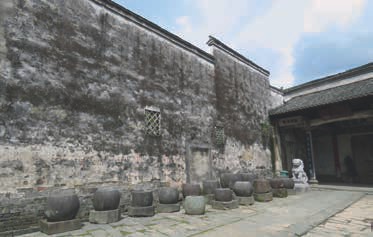
The courtyard in front of the temple is lined on either side by eighteen pairs of impressive stone steles. It's said that in the early days, members of the Ni clan whose offspring successfully passed the imperial examinations with a certain rank were allowed to erect a pair of stone poles in front of the ancestral shrine, to pass down the family honor to future generations. One might well wonder how these stone monuments made it through the Cultural Revolution undamaged; the answer is that the people of the Ni clan transported them all down the river, to the front of the village and buried them under silt, to safely preserve them throughout the revolution.
Learning of this history left us to contemplate the power behind this vast cultural legacy. Deep in thought, you will wander through Zhenyi Temple, paying a visit to the old residence on the left, toward the back of the hall. The residence is known as "One Government, Six Counties," and is also known among locals as the "new house" and the "imperial palace." It is representative of Qimen residences from the Ming and Qing dynasties.

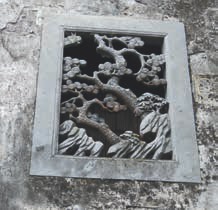

The name "One Government, Six Counties" describes the architectural layout of the residence and refers to the six counties that were under the jurisdiction of the Huizhou government. Mansions of this type had a large courtyard with one "government" hall and six "county" halls. The "government" hall was the main reception hall, used for receiving guests and holding banquets. The "county" halls were the day-to-day living quarters of the family. The mansion was built in 1884 and covers an area of 1,600 square meters. It was the residence of Ni Wangzhong (倪望重), who passed the highest imperial civil service examination during the reign of the Qing emperor Tongzhi. Ni Wangzhong was a prefectural magistrate of Zhejiang Province, while his younger brother, Ni Wanglong (倪望隆) was a county head magistrate in the south of Jiangxi Province. The two brothers lived together in the one, big mansion. Since the family had officials at both the prefecture and county level, this gave rise to the "One Government, Six Counties" name.
The whole mansion is splendid and elegant. Each of the county halls is exquisitely decorated, with rooms off to the side, verandas for ventilation and light, and multiple stories above the main hall. The walls, from both inside and out, are decorated with breathtakingly ornate carvings. From the beams to the archways, from the pillars to the windows, the historic charm of the residence greets one's eyes at every turn. The features surrounding the verandas - the eaves, stone walls, partition screens, lotus gates and pillars - are all made of the finest brick, wood and carved stone. There's a saying that goes: "Every hall has its veranda, and no dwelling lacks carvings." This mansion certainly exemplifies the saying and offers us a window into classical life and culture in Huizhou.
The old houses and residences in Qimen's villages are an embodiment of Huizhou culture, with a distinctive style that is quiet and understated. The passing time has brought a sense of age and history to the area, and the stones, wood, pillars, roofs and windows are all subtly imbued with the echoes of their cultural legacy, inspiring nostalgia for lost ages. You will walk through time in these places.

So, on our cultural journey through Qimen County, we've seen old residences, ancient trees and elegant pavilions. We've passed by houses and crossed little bridges over rushing streams; we've admired the natural beauty of Guniujiang with its mountains and jade-green waters. All of this exploration paints a vivid backdrop to the history and culture of Qimen's teas: the fragrant and flamboyant Qimen red tea, the Liu An tea of Luxi with its rich history and the traditional Maofeng green tea of the villages. Brimming with countless stories and endless enchanting landscapes, this fascinating region really is an earthly echo of the fabled Peach Blossom Spring.
